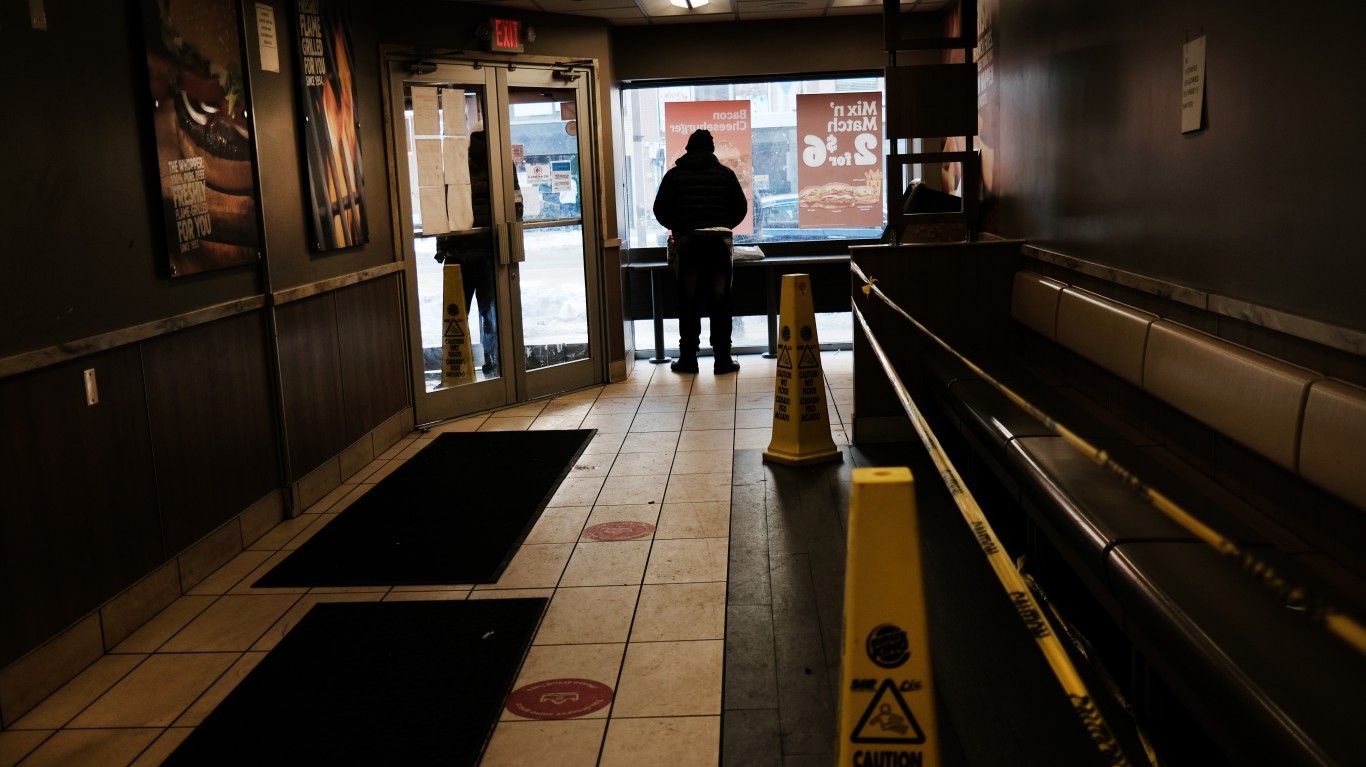
Americans are leaving their jobs in record numbers. In a continuation of what has been dubbed “The Great Resignation”, some 4.4 million Americans quit their jobs in September 2021, an all-time high that broke the previous record of 4.3 million set just one month earlier.
Experts speculate that the broad trend is attributable to the pandemic, which has caused many Americans to re-evaluate their life’s priorities. The pandemic has also led to multiple rounds of government stimulus payments, giving many lower-income workers the financial freedom to leave their job.
The historic number of separations of workers from their job is more likely to affect certain occupations. Using data from the Bureau of Labor Statistics, 24/7 Wall St. identified the 26 jobs you are most likely to leave. Occupations are ranked by the separation rate — the share of the workforce projected to leave each year between 2019 and 2029. The separation rate not only includes workers who quit, but also those who are fired, or laid off.
It is important to note that even before the pandemic, turnover in most of the occupations on this list was higher than average. Many of these occupations are entry level positions, and while they have high separation rates, open positions are usually filled with new hires. In fact, in most occupations on this list, overall employment is projected to increase in the coming years.
One of the most common reasons Americans choose to quit is to take another job with a higher salary. In nearly every occupation on this list, salaries are well below average. Only three occupations on this list have a higher median annual wage than the $41,950 median across all occupations. In most of the jobs with the highest separation rates, the median annual wage is below $30,000. Here is a look at the 25 lowest paying jobs in America.
Many of the occupations on this list are those that were affected more than most by mandatory shutdowns during the pandemic, such as those in the entertainment or food services industries. Both quits and layoffs have been widespread in these sectors since the beginning of the pandemic. Other occupations on this list can be physically or psychologically demanding, factors that can push workers to look for opportunities that take less of a toll. Here is a look at the most dangerous jobs in America.
Click here to see the 26 jobs you are most likely to leave
Click here to read our detailed methodology

26. Embalmers
> Projected annual separations rate, 2019-2029: 15.1%
> Employment: 3,900
> 10-yr. projected employment change: -300 (-7.6%)
> Median annual wage: $47,630
Embalmers is projected to be a high turnover occupation. An estimated 15.1% of embalmers will leave their job each year over the next decade, a far larger share than the 10.2% of American workers across all occupations. Embalming is the process of preparing a deceased body for viewing by friends and family. The majority of exits from these jobs will be retirements. Embalmers are retiring at a faster than average rate.
As is the case with many occupations on this list, embalming can be stressful and demanding work. Embalmers often have long shifts and may work with those who died under traumatic circumstances. Additionally, they frequently work in close proximity to unpleasant sights and odors.
[in-text-ad]

25. Funeral attendants
> Projected annual separations rate, 2019-2029: 15.1%
> Employment: 34,300
> 10-yr. projected employment change: -1,000 (-2.9%)
> Median annual wage: $29,150
An average of about 5,100 Americans working as funeral attendants are projected to leave their job each year over the next decade, equal to 15.1% of the occupation’s workforce. The majority of these separations will be due to retirements.
Funeral attendant duties typically include placing a casket in a venue prior to a funeral service, as well as arranging flowers and lights and directing and escorting mourners. Like many occupations on this list, funeral attendants do not generally have high incomes. The median salary in the occupation is just $29,150, well below the $41,950 median across all occupations.

24. Hotel, motel, and resort desk clerks
> Projected annual separations rate, 2019-2029: 15.1%
> Employment: 276,500
> 10-yr. projected employment change: -19,100 (-6.9%)
> Median annual wage: $25,490
An estimated 40,400 Americans working as desk clerks at resorts, hotels, and motels will leave their job each year over the next decade.This will be in no small part due to layoffs. By 2030, the number of Americans working in the occupation is projected to fall by nearly 7%.
Many will also voluntarily leave the occupation, potentially to find a higher-paying career. The median annual salary of a hotel desk clerk is only $25,490 a year, while most occupations pay at least $41,900 annually.

23. Exercise trainers and group fitness instructors
> Projected annual separations rate, 2019-2029: 15.1%
> Employment: 373,700
> 10-yr. projected employment change: +57,600 (+15.4%)
> Median annual wage: $40,510
Exercise trainers and group fitness instructors is one of several physically demanding occupations to rank on this list. These workers typically conduct training sessions in any number of environments, including gyms, studios, and clients’ homes — often working on nights, weekends, and holidays. Each year through 2029, about 15.1% of trainers and fitness instructors, or 60,700 people, are projected to leave their job — either retiring or switching careers.
While exercise training and group fitness instruction has high turnover, it is one of the fastest growing fields in the country, with more new instructors joining the field than leaving. As Americans grow increasingly aware of the importance of healthy lifestyles, and employers continue to incentivise gym memberships, employment for trainers and fitness instructors is projected to climb by 15.4% between 2019 and 2029, with a net gain of 57,600 new jobs.
[in-text-ad-2]

22. Recreation workers
> Projected annual separations rate, 2019-2029: 15.1%
> Employment: 417,100
> 10-yr. projected employment change: +41,500 (+10.0%)
> Median annual wage: $28,440
Recreation workers lead activities in summer camps, recreation centers, nursing care facilities, parks, and more. Turnover is high in the occupation. About one in seven people in this field are projected to leave the occupation annually between 2019 and 2029, amounting to about 66,000 people per year.
Most of the people leaving their jobs as recreational workers are switching jobs, not leaving the labor force altogether. This may be due in part to the seasonal nature of many jobs in the occupation, or the fact that the typical recreation worker earns just $28,440, well below the median annual wage of $41,950 for all jobs.

21. Choreographers
> Projected annual separations rate, 2019-2029: 15.3%
> Employment: 5,500
> 10-yr. projected employment change: +800 (+14.0%)
> Median annual wage: $43,680
There are an estimated 5,500 choreographers working in the United States — creating new dances or interpretations of existing dances, auditioning dancers, and teaching complex dance movements, among other duties. An estimated 15.3% of choreographers, or about 900 people, will leave the occupation each year over the next decade. Despite the high turnover, employment is expected to increase through 2029.
While many choreographers will retire in the coming years, others may choose to leave the occupation to transition into a less demanding job. Choreographer jobs are concentrated in large cities like Las Vegas and New York, and when doing tours, choreographers can have long days of rehearsal followed by performance.
[in-text-ad]

20. Dancers
> Projected annual separations rate, 2019-2029: 15.3%
> Employment: 11,400
> 10-yr. projected employment change: +300 (+2.3%)
> Median annual wage: N/A
Dancers can work in a range of environments, from casinos and cruise ships to traveling dance companies and in music videos. The job can take a considerable toll on performers’ bodies, and dancers are among the most likely workers to sustain an injury on the job. The demanding physical nature of the work likely explains the high turnover. Each year, an estimated 15.3% of dancers — about 1,800 people — in the United States either move on to a new career or leave the workforce entirely.
The number of dancers in the workforce is projected to grow by a modest 2.3% between 2019 and 2029.

19. Food cooking machine operators and tenders
> Projected annual separations rate, 2019-2029: 15.6%
> Employment: 30,400
> 10-yr. projected employment change: +200 (+0.5%)
> Median annual wage: $33,010
Food cooking machine operators and tenders is an occupational category that encompasses a number of jobs involved in the use and maintenance of kitchen equipment such as fryers, ovens, cookers, and peelers. The occupation has one of the highest turnover rates in the country, with an estimated 15.6% of the workforce projected to leave annually over the next decade.
While some of these workers are expected to retire in the coming years, the bulk of the turnover is expected to come from people moving on to different occupations. Working in kitchens can be fast paced, stressful, and uncomfortable. Additionally, the typical worker in the occupation makes just $33,010 a year, well below the median annual wage of $41,950 for all jobs.

18. Bartenders
> Projected annual separations rate, 2019-2029: 15.6%
> Employment: 654,700
> 10-yr. projected employment change: +38,400 (+5.9%)
> Median annual wage: $24,960
According to BLS projections, just over one in every 10 bartenders working in the United States will transfer to a new occupation, and nearly one in every 20 will leave the labor force entirely each year until 2029. All told, about 104,900 bartenders are expected to leave their job annually over roughly the next decade.
Bartenders have repetitive and often stressful work. Their work hours can go late into the night and often include shifts on weekends and holidays. As is often the case among the jobs on this list, bartenders are not required to have any formal education.
[in-text-ad-2]

17. Tour and travel guides
> Projected annual separations rate, 2019-2029: 15.8%
> Employment: 57,300
> 10-yr. projected employment change: +3,100 (+5.4%)
> Median annual wage: $29,460
There are some 57,300 Americans working as tour and travel guides, leading sightseeing groups through places of interest — and nearly 16% of them are projected to leave the occupation annually over the next decade. Many of them will retire, but the largest share of those who will leave the job will move on to a different occupation.
Jobs with the highest separation rates tend to be low paying, and tour and travel guides are no exception. The typical worker in the occupation makes just $29,460 a year, well below the median annual wage of $41,950 for all jobs.

16. Dining room and cafeteria attendants and bartender helpers
> Projected annual separations rate, 2019-2029: 15.8%
> Employment: 488,000
> 10-yr. projected employment change: +31,900 (+6.5%)
> Median annual wage: $25,010
The separation rate among dining room and cafeteria attendants and bartender helpers is a projected 15.8%. Of the 79,800 Americans expected to leave the profession annually in the coming years, about half will retire and half will move into a different occupation.
Workers often change jobs with the goal of earning a higher salary — and most jobs pay much more than what dining room and cafeteria attendants and bartender helpers earn. The median annual salary in the occupation is just $25,010, well below the median annual wage of $41,950 for all jobs.
[in-text-ad]

15. Food preparation workers
> Projected annual separations rate, 2019-2029: 15.9%
> Employment: 886,700
> 10-yr. projected employment change: -9,500 (-1.1%)
> Median annual wage: $26,070
Food preparation workers are assigned tasks by cooks, chefs, and managers in the kitchens of places like restaurants, cafeterias, and hotels. An estimated 140,400 Americans will leave the profession each year over roughly the next decade. While some of them will retire, the bulk of separations will be food preparation workers looking for a new job.
As is often the case in occupations with high turnover, food prep workers can have demanding schedules — working early mornings, late nights, holidays, and weekends. The work can be fast paced, stressful, and physically demanding, while compensation is usually low. The typical food preparation worker earns just $26,070, well below the median annual wage of $41,950 for all jobs.

14. Crossing guards and flaggers
> Projected annual separations rate, 2019-2029: 16.7%
> Employment: 86,700
> 10-yr. projected employment change: +5,000 (+5.7%)
> Median annual wage: $30,790
According to BLS projections, an average of about 16.7% of all crossing guards working in the United States will leave the job every year through 2029. Of the 14,900 Americans expected to leave the job annually, about 3,600 will likely move on to other occupations, and 11,300 will leave the labor force entirely.
As is the case with the majority of jobs with high turnover, wages for crossing guards are relatively low. The median wage of a crossing guard is only $30,790 a year, while the median annual wage across all occupations is about $42,000.

13. Models
> Projected annual separations rate, 2019-2029: 16.8%
> Employment: 2,700
> 10-yr. projected employment change: +0.5%
> Median annual wage: $31,910
Models pose for artists and photographers, often to advertise a product. Unlike many jobs with lower turnover, models’ work schedules tend to be inconsistent and less predictable, and the job requires no formal education. Models often must fit within a certain height and weight range. Every year between now and 2029, the BLS projects that about 300 models will retire and another 200 will transfer to a new career.
Workers will often change jobs with the goal of earning a higher salary — and most jobs pay a lot more than what most models earn. The median annual salary in the occupation is just $31,910, well below the median annual wage of $41,950 for all jobs.
[in-text-ad-2]

12. Demonstrators and product promoters
> Projected annual separations rate, 2019-2029: 16.8%
> Employment: 88,100
> 10-yr. projected employment change: +2,700 (+3.1%)
> Median annual wage: $32,500
Demonstrators and product promoters show off merchandise and answer questions for the purpose of creating public interest in buying a product. Many also sell the demonstrated merchandise.
Over the next decade, an estimated 15,000 Americans working as promoters will leave the job, equal to about 16.8% of the occupation’s total workforce. Only about one-third of those who will leave will likely move into a new occupation, while the remainder are projected to leave the workforce entirely.

11. Gambling change persons and booth cashiers
> Projected annual separations rate, 2019-2029: 16.9%
> Employment: 21,700
> 10-yr. projected employment change: +500 (+2.5%)
> Median annual wage: $27,080
Gambling change persons and booth cashiers exchange chips and tokens for money in casinos. The number of Americans working in this field is projected to increase modestly in the next decade, climbing by about 2.5%.
Few jobs have higher turnover rates than gambling change persons and booth cashiers. The BLS projects that about 3,700 Americans in the occupation, 16.9% of the occupation’s workforce, will leave each year over roughly the next decade. While about half of them will leave the labor force entirely, the remainder will transition into a new occupation — and many of them will likely do so to earn a higher salary. The typical gambling change person earns just $27,080, well below the median annual wage of $41,950 for all jobs.
[in-text-ad]

10. Cashiers
> Projected annual separations rate, 2019-2029: 16.9%
> Employment: 3,600,900
> 10-yr. projected employment change: -265,300 (-7.4%)
> Median annual wage: $25,020
An estimated 585,100 Americans working as cashiers will leave their job each year over roughly the course of the next decade, or about 16.9% of those working in the occupation — one of the highest turnover rates.
Like many occupations with high separation rates, the duties of a cashier are often repetitive without variation. Cashiers also typically spend much of the workday on their feet. Many of those leaving will likely search for a profession with higher wages, as the median annual wage of cashiers of $25,020 is one of the lowest wages of any job.

9. Waiters and waitresses
> Projected annual separations rate, 2019-2029: 17.5%
> Employment: 2,613,800
> 10-yr. projected employment change: +97,600 (+3.7%)
> Median annual wage: $23,740
Between 2019 and 2029, 17.5% of people working as wait staff are expected to leave the job each year, one of the highest separation rates. Like many jobs on this list, working as a waiter or waitress can be stressful and physically demanding. Those in the job spend most working hours on their feet, often carrying heavy trays in a hectic and fast-paced environment.
According to the BLS, large occupations typically have more openings than small ones, regardless of growth or replacement needs. Wait jobs are one of the nation’s largest occupations, with 2.6 million jobs across the U.S.

8. Fast food and counter workers
> Projected annual separations rate, 2019-2029: 18.2%
> Employment: 4,047,700
> 10-yr. projected employment change: +460,900 (+11.4%)
> Median annual wage: $23,860
Fast food and counter workers are one of many occupations in the food service industry to rank on this list. The job typically entails taking orders and payments and serving customers from behind the counter. Over roughly the next decade, an estimated 780,500 Americans working in this occupation will leave the job each year.
While some will retire from the job market entirely, many will move into different, likely higher-paying occupations. The typical fast food counter worker earns just $23,860 a year, nearly the lowest median annual wage of any occupation.
[in-text-ad-2]

7. Costume attendants
> Projected annual separations rate, 2019-2029: 20.7%
> Employment: 7,700
> 10-yr. projected employment change: +400 (+4.7%)
> Median annual wage: $42,910
Costume attendants typically work in entertainment, selecting, sizing, and caring for costumes used by performers. The occupation has one of the highest turnover rates in the country, as more than one in every five costume attendants are projected to leave their job annually over roughly the next decade.
Costume attendants are among the few occupations with the highest separation rates where wages are higher than average. The typical costume attendant earns nearly $43,000 a year, about $1,000 more than the median salary across all occupations.

6. Locker room, coatroom, and dressing room attendants
> Projected annual separations rate, 2019-2029: 20.7%
> Employment: 16,800
> 10-yr. projected employment change: +1,400 (+8.1%)
> Median annual wage: $26,700
Locker room, coatroom, and dressing room attendants is an occupational category that covers several jobs, including coat check attendant, athletic equipment manager, and spa attendant. According to BLS projections, an average of 3,600 Americans working in these roles, or about one in every five workers, will leave the job annually through 2029.
The majority of those leaving the occupation will move into a different job — and likely a higher-paying one. The median salary for among locker room, coatroom, and dressing room attendants is just $26,700, well below the median annual income among all jobs of $41,950.
[in-text-ad]

5. Amusement and recreation attendants
> Projected annual separations rate, 2019-2029: 20.7%
> Employment: 357,700
> 10-yr. projected employment change: +37,000 (+10.3%)
> Median annual wage: $24,760
Amusement and recreation attendants work in places like ski mountains, golf courses, amusement parks, and sports complexes. An average of about one in every five of these workers will leave their job each year for roughly the next decade, according to BLS projections.
The high turnover rate among the amusement and recreation attendants may be due in part to the seasonal nature of many of these types of jobs. Many may also be looking to transition into a higher-paying occupation. The median salary for amusement and recreation attendants is just $24,760, well below the median annual income among all jobs of $41,950.

4. Hosts and hostesses, restaurant, lounge, and coffee shop
> Projected annual separations rate, 2019-2029: 21.1%
> Employment: 429,700
> 10-yr. projected employment change: +35,200 (+8.2%)
> Median annual wage: $23,880
An estimated 94,500 hosts and hostesses working in restaurants, lounges, and coffee shops will leave their job each year through 2029, according the projections from the BLS. These workers typically greet customers and show them to their tables, spending much of the workday on their feet.
As is often the case for occupations with high separation rates, wages are not high for hosts and hostesses. The typical worker in the industry earns only $23,880, nearly the lowest of any occupation in the country and about $18,000 less than the median income among all occupations.

3. Motion picture projectionists
> Projected annual separations rate, 2019-2029: 22.1%
> Employment: 4,700
> 10-yr. projected employment change: -500 (-11.2%)
> Median annual wage: $27,490
According to BLS projections, 22.1% of all Americans working as motion picture projectionists will leave the job each year over roughly the next decade. Many of those separations are likely to be involuntary as the number of jobs in the field is projected to decline by 11.2% from 2019 to 2029. Of the 1,000 people expected to leave the job each year, about half are expected to transfer to another occupation and the other half will likely leave the workforce entirely.
Many will also likely leave the occupation voluntarily for a higher-paying job opportunity. The median salary for motion picture projectionists is just $27,490, well below the median annual income among all jobs of $41,950.
[in-text-ad-2]

2. Ushers, lobby attendants, and ticket takers
> Projected annual separations rate, 2019-2029: 22.2%
> Employment: 139,000
> 10-yr. projected employment change: +4,700 (+3.3%)
> Median annual wage: $25,110
Ushers, lobby attendants, and ticket takers have one of the highest turnover rates of nearly any other occupation. According to the BLS, 22.2% of Americans in the profession will either exit the workforce or move to a new career each year in the next decade.
The primary responsibilities of ushers, lobby attendants, and ticket takers include collecting admission passes for shows or events, showing patrons to their seats, and looking for lost articles — repetitive work that requires little in the way of training or formal education. The median annual wage for these workers is just $25,110 — well below the median of $41,950 across all occupations.

1. Lifeguards, ski patrol, and other recreational protective service workers
> Projected annual separations rate, 2019-2029: 24.3%
> Employment: 149,800
> 10-yr. projected employment change: +13,500 (+9.0%)
> Median annual wage: $25,020
The separation rate among lifeguards, ski patrol, and other recreational protective service workers is the highest of any occupation in the country. Nearly one in every four of these workers will either move to a new occupation or retire each year over roughly the next decade.
The high turnover rate among these workers may be due in part to the seasonal nature of many of these types of jobs. Many may also be looking to transition into a higher-paying occupation. The median salary for amusement and recreation attendants is just $25,020, well below the median annual income among all jobs of $41,950.
Methodology
To identify the jobs you are most likely to lose or leave, 24/7 Wall St. reviewed the annual average projected job separations rate for the period of 2019 to 2029 for over 700 detailed occupations tracked by the Bureau of Labor Statistics’ Employment Projections program. Annual average separation rates represent the percentage of workers projected to permanently leave an occupation each year and are the sum of labor force exits and occupational transfers.
Supplemental data on educational attainment rates for 2019 and typical education requirements by occupation also came from the BLS. Median annual wage for each job in 2020 came from the BLS Occupational Employment Statistics program.
Total separations include quits, layoffs and discharges, and other separations. Total separations are referred to as turnover. Quits are generally voluntary separations initiated by the employee. Therefore, the quits rate can serve as a measure of workers’ willingness or ability to leave a job. Layoffs and discharges are involuntary separations initiated by the employer. Other separations include separations due to retirement, death, disability, and transfers to other locations of the same company.
Jobs classified by the BLS as “all other” — a catch all designation that does not denote a specific field — were excluded from analysis. In the case of a tie, the occupation with the largest workforce in 2019 ranked higher on the list.
Are You Still Paying With a Debit Card?
The average American spends $17,274 on debit cards a year, and it’s a HUGE mistake. First, debit cards don’t have the same fraud protections as credit cards. Once your money is gone, it’s gone. But more importantly you can actually get something back from this spending every time you swipe.
Issuers are handing out wild bonuses right now. With some you can earn up to 5% back on every purchase. That’s like getting a 5% discount on everything you buy!
Our top pick is kind of hard to imagine. Not only does it pay up to 5% back, it also includes a $200 cash back reward in the first six months, a 0% intro APR, and…. $0 annual fee. It’s quite literally free money for any one that uses a card regularly. Click here to learn more!
Flywheel Publishing has partnered with CardRatings to provide coverage of credit card products. Flywheel Publishing and CardRatings may receive a commission from card issuers.
Thank you for reading! Have some feedback for us?
Contact the 24/7 Wall St. editorial team.
 24/7 Wall St.
24/7 Wall St. 24/7 Wall St.
24/7 Wall St.


